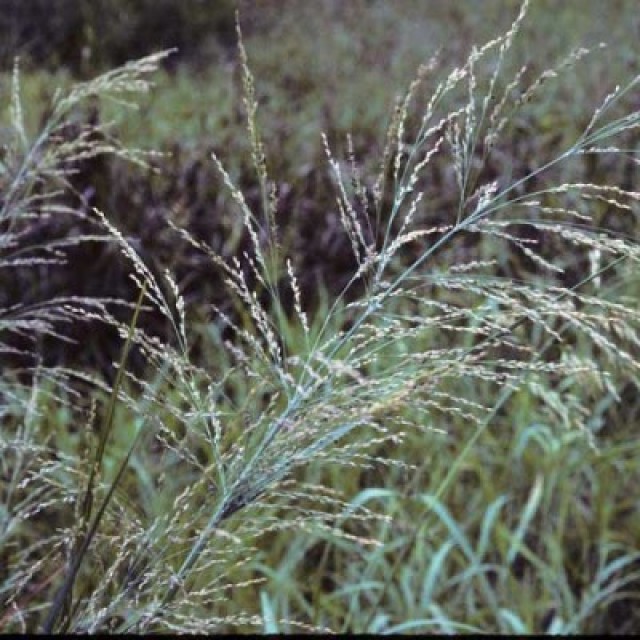COMMON NAME
Switchgrass
SCIENTIFIC NAME
Panicum virgatum
ALSO KNOWN AS
Blackbent, Tall panic grass, Tall prairie grass, Thatchgrass, Wild redtop
Plant family
Grass (Poaceae)
Plant group
Grasses
Switchgrass is a native perennial bunchgrass found in most of eastern North America that grows up to 6 feet tall.
552 reports
42+
OBSERVERS
552+
OBSERVATIONS
Identification hints
Switchgrass is a large grass growing with bluestem and indian grass species in tallgrass prairies. It is distinctive in having flowers in large open panicles (loose and many-branched). The leaves are generally 30-90 cm long. When the seeds ripen in the fall, they often turn a pink to purple to golden color. Indiangrass (sorghastrum) also has big panicles but its panicles are silky hairy and its spikelets are golden brown.
Did you know?
Switchgrass is a key species of the tall grass prairie. It is used for forage and ornamental use. Switchgrass has several cultivars. As a crop, switchgrass is self seeding, which means that farmers do not have to plant and re-seed after annual harvesting. Once established, switchgrass can survive for ten years or longer. Switchgrass is also considered a potential source of biofuel, and a lot of money has been invested in developing it as such. It was considered good candidate for use as a biofuel because of its prodigious growth and tolerance of a wide variety of conditions.
DISTRIBUTION IN TH U.S.
Alabama
,
Arkansas
,
Arizona
,
Colorado
,
Connecticut
,
Delaware
,
Florida
,
Georgia
,
Hawaii
,
Iowa
,
Idaho
,
Illinois
,
Indiana
,
Kansas
,
Kentucky
,
Louisiana
,
Massachusetts
,
Maryland
,
Maine
,
Michigan
,
Minnesota
,
Missouri
,
Mississippi
,
Montana
,
North Carolina
,
North Dakota
,
Nebraska
,
New Hampshire
,
New Jersey
,
New Mexico
,
Nevada
,
New York
,
Ohio
,
Oklahoma
,
Pennsylvania
,
Rhode Island
,
South Carolina
,
South Dakota
,
Tennessee
,
Texas
,
Utah
,
Virginia
,
Vermont
,
Wisconsin
,
West Virginia
,
Wyoming
HABITAT
Switchgrass is a versatile and adaptable plant. It can grow in many types of weather conditions and soil types. It grows particularly well in the areas of tallgrass prairies. Switchgrass also grows on dry slopes, sand, open woodlands, shores, riverbanks, and marshes. It grows best when there is adequate moisture and deep rich soil.
ATTRIBUTES
Leaves
Leaves are alternate, have rough edges, and can be floppy at up to twenty inches long and up to a half inch wide. Leaves are hairless except near the base of the plant, where they are covered in hairs. The leaf wraps around the stem creating a distinct “V” shape little tufts of hairs on the sides. The nodes along the stem are purplish.
Flowers
Flowers are arranged in spikelets along branches that are clustered in a pyramidal shape. Spikelets are attached with a stalk to open branches that are attached to the main flower stem. The main flower stems vary in size from 4 to 22 in (10 to 56 cm) long and about 1.5 to 8 in (4 to 20 cm) wide. The tiny spikelets are egg-shaped, solitary, and found at the ends of the long branches. The spikelets are 0.1 to 0.2 in (0.25 to 0.5 cm) long. The distinctive stamens and styles of the flowers are orange and purple.
Fruits
As spikelets mature they turn tan and contain seeds that are tiny, brown and oval-shaped.
Bloom Time
The leaves begin to develop as early as March. Flowering begins in June in much of its range but can occur through November. Switchgrass seeds are found in late August to early September, but can be dispersed in late fall and early winter depending on latitude and elevation. As a warm season perennial grass, most of its growth occurs from late spring through early fall. It becomes dormant and unproductive during the colder months. The productive season in its northern habitat can be as short as three months, but in the southern reaches of its habitat, the growing season may be as long as eight months (around the Gulf Coast area).
See Menu
Budburst is a project of the
Chicago Botanic Garden
One of the treasures of the
Forest Preserves of Cook County
Creative Commons
BY-NC-SA 4.0
- 2021 Chicago Botanic Garden. All Rights Reserved.
- Terms of Use
- Privacy Policy
- Data Sharing and Citation Policies
- 2021 Chicago Botanic Garden. All Rights Reserved.



